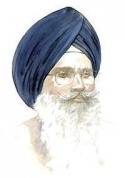Template:AOW6: Difference between revisions
Hari singh (talk | contribs) No edit summary |
(Correcting capitalization.) |
||
| Line 2: | Line 2: | ||
{{ps|Image:Turban sikh.jpg|<small>[[Sikh]] man with a [[Turban]]</small>}} | {{ps|Image:Turban sikh.jpg|<small>[[Sikh]] man with a [[Turban]]</small>}} | ||
The [[ | The [[turban]] is closely associated with [[Sikhism]]. Sikhism or Sikhi is the only religion in the world in which the wearing of a turban is mandatory for all adult males. | ||
Vast majority of people who wear [[turban]]s in Western countries are [[Sikh]]s. The Sikh turban is also called the '''pagdi''' or '''dastaar''', which is a more respectful word in [[Punjabi]] for the turban. | Vast majority of people who wear [[turban]]s in Western countries are [[Sikh]]s. The Sikh turban is also called the '''pagdi''' or '''dastaar''', which is a more respectful word in [[Punjabi]] for the turban. | ||
| Line 8: | Line 8: | ||
All these words refer to the garment worn by both men and to a lesser extent by women to cover their heads. Some women prefer to wear a [[chunni]] instead of a [[turban]]. | All these words refer to the garment worn by both men and to a lesser extent by women to cover their heads. Some women prefer to wear a [[chunni]] instead of a [[turban]]. | ||
The | The dastaar is a headdress consisting of a long scarf-like single piece of fine cloth wound round the head or sometimes over an inner "hat" or [[patka]]. Traditionally in [[India]], the turban was only worn by men of high status in society; men of low status or of lower castes were not allowed or could not afford to wear a [[turban]]. | ||
Sikh's are famous for their distinctive turbans. The turban represents respectability, and is a sign of nobility. <!---A turbaned Sikh stands out from the crowd and is easily recognizable. The '''dastaar''', as the Sikh turban is more commonly known as is an [[article of faith]]. This was made mandatory by [[Guru Gobind Singh]], the founders of [[Khalsa]] and all baptised male [[Sikh]]s are required to wear a ''' | Sikh's are famous for their distinctive turbans. The turban represents respectability, and is a sign of nobility. <!---A turbaned Sikh stands out from the crowd and is easily recognizable. The '''dastaar''', as the Sikh turban is more commonly known as is an [[article of faith]]. This was made mandatory by [[Guru Gobind Singh]], the founders of [[Khalsa]] and all baptised male [[Sikh]]s are required to wear a '''dastaar'''. It is not to be regarded as mere cultural paraphernalia. ---> {{aowf|Turban}} | ||
Latest revision as of 23:41, 3 January 2016
The turban is closely associated with Sikhism. Sikhism or Sikhi is the only religion in the world in which the wearing of a turban is mandatory for all adult males.
Vast majority of people who wear turbans in Western countries are Sikhs. The Sikh turban is also called the pagdi or dastaar, which is a more respectful word in Punjabi for the turban.
All these words refer to the garment worn by both men and to a lesser extent by women to cover their heads. Some women prefer to wear a chunni instead of a turban.
The dastaar is a headdress consisting of a long scarf-like single piece of fine cloth wound round the head or sometimes over an inner "hat" or patka. Traditionally in India, the turban was only worn by men of high status in society; men of low status or of lower castes were not allowed or could not afford to wear a turban.
Sikh's are famous for their distinctive turbans. The turban represents respectability, and is a sign of nobility. .....More

